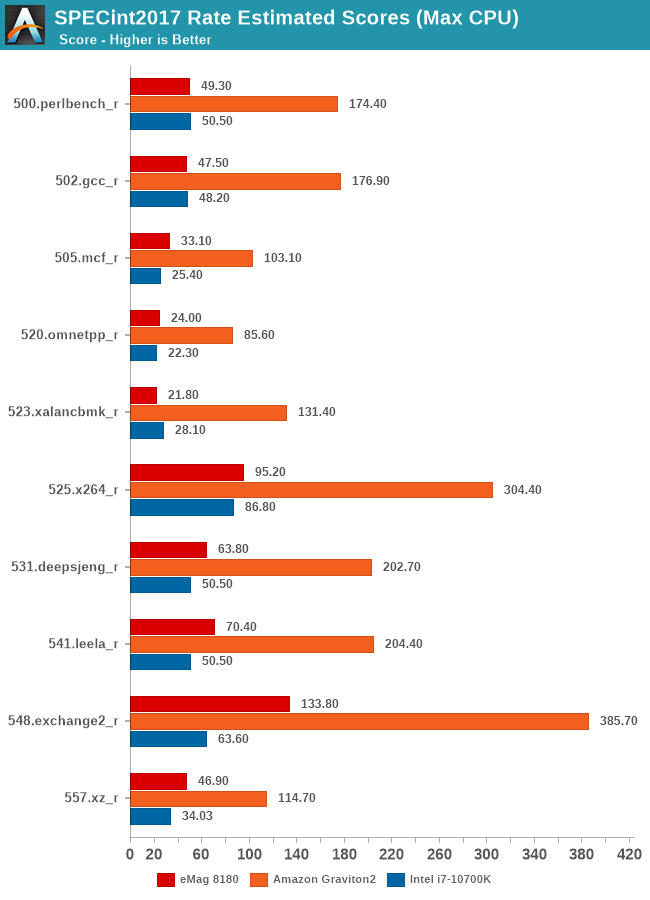Avantek's Arm Workstation: Ampere eMAG 8180 32-core Arm64 Review
by Andrei Frumusanu on May 22, 2020 8:00 AM ESTSPEC2006 & 2017: Weak ST Performance
Of course, while maybe the individual cores might not be all that performant, the chip employs 32 of them. Together with the 32MB L3 cache as well as the 8-channel DDR4-2666 memory interface certainly the system should be able to showcase better multi-core results.


Indeed, the chip does better in the tests, at least more often than not being able to beat the consumer-grade Intel CPU. The performance scaling of the eMAG system also isn’t bad at all – scaling from 1 core to 32 cores sees the performance scale with an average factor of 0.73x per core, and a median per SPEC2006 and 2017 test of 0.78x; that’s much better scaling than Amazon’s Graviton2 when scaling ST performance to its full 64 cores.

Still, the MT results, while beating the Intel system, still don’t look all that great when considering the fact that we’re talking about 8 cores vs 32 cores. A 400% advantage in cores for only a 30% performance advantage.
The Graviton2 naturally eclipses both comparisons here, and the only reason to consider this chip’s figures is that Ampere’s upcoming Altra processor with 80 cores and 3GHz should be notably faster than the Amazon chip.










35 Comments
View All Comments
vFunct - Friday, May 22, 2020 - link
They really need ARM systems that are a little higher than Raspberry-PI but a little lower than x86, perhaps in the $100-$200 price range, for personal network appliances.Death666Angel - Friday, May 22, 2020 - link
I'd be interested in what you would use that one for? And why exactly those specs? Lower power than x86 at "good enough" performance levels? If that is the base, why not do an undervolted / down clocked x86 build? Ryzen can get to some pretty great voltage/frequency levels. :D Or is it the ATX form factor as well? That one is a bit trickier, either go with a 12/19V native motherboard or get a nice pico PSU with ATX cables and a 12/19V input. :) Unless I'm way off base in my assumptions. :Dlmcd - Friday, May 22, 2020 - link
I haven't used an RPi 4 yet but I'd be willing to bet the 4GB variant would meet vFunct's needs.vFunct - Friday, May 22, 2020 - link
Network file server with ZFS, Or, a mail server.Need storage & memory, but don't need intense CPU
vFunct - Friday, May 22, 2020 - link
Network file server with ZFS, Or, a mail server.Need storage & memory, but don't need intense CPU.
Wilco1 - Friday, May 22, 2020 - link
It's worth pointing out for future reviews that GCC 10 is out and shows a 10.5% performance gain on Neoverse N1: https://community.arm.com/developer/tools-software...SarahKerrigan - Friday, May 22, 2020 - link
Doesn't mean much for eMag, though.Wilco1 - Saturday, May 23, 2020 - link
Indeed, eMag is quite old, so it won't benefit nearly as much as the latest microarchitectures.GreenReaper - Sunday, May 24, 2020 - link
The graph at the end suggests that 10.0 was a significant regression for many tests, though, so that should probably be taken with a pinch of salt. <^_^>There are some tests (mostly vectorization-related) where it's really helped, though.
mrvco - Friday, May 22, 2020 - link
Out of curiosity, how would the performance of the eMag compare to a typical single-board ARM computer? My reference point would be the RPi3 or 4, but there seem to be a variety of others ranging up to a couple hundred dollars with (allegedly) 'better' performance than the RPi.